The most qadash place, (Debir):
the Qadash
of Qadash
It was a room shaped like a cube: about 30 feet in length, width and height. Thus its height was about 15 feet lower than that of the preceding room. And yet it seemed that the flat roof was everywhere on the same level. The difference is therefore explicable by a raising of the floor level, above which a kind of loft had been constructed. From this, a flight of steps led from the Qadash place (Hekal) to the most Qadash place (Debir).
The stone-work of its walls, like that of the Hekal, was concealed by cedar-wood paneling, covered by gold leaf. 21
Light penetrated here only once a year and then very briefly. This was when the high-kohen entered on the Day of Expiation. Normally, the Ark, which held the Tables of the Law but was principally YAHWEH's throne, remained in complete darkness and utter silence.
On Sinai, the Ark had been crowned by two little statues of gilded cherubs with outstretched wings. Their proportions were perfectly right for the quite small naos, and for the practical purpose of transport through the desert. But, in Solomon's day, the sons of Yacob no longer wandered. The shepherds had become cultivators or craftsmen, and the Ark had left the roads for a permanent settlement in the Great Tabernacle. From that time onwards the little cherubs disappear and we do not know what became of them, but as soon as the Ark had taken up position in the Qadash of Qadash they were replaced by two huge statues -sixteen feet high, half the height of the room. Their outstretched wings covered the entire wall surface, thirty-two feet across. They were made of olive wood, gilded, and faced each other across the middle of the Debir: gigantic Kerubim who seemed to enfold the Ark under the protection of their mighty wings!
The advice of the Phoenician craftsmen must have been followed. For the cherubs of Sinai which were very suitable for an Ark with an existence that alternated between wandering and brief halts in the tent, were no longer relevant to the new monumental situation. Something grander became a necessity. And so, in the darkness of the stone-built Qadash of Qadash, the great Kerubim watched on either side of YAHWEH's throne.
21 This ubiquitous presence of gold on walls, furniture and doors, was held, even as late as the beginning of this century, to have been systematically exaggerated, in order to provoke the reader's wonder. But what is now known, through excavation, about the decoration of temples of Egypt, Phoenicia and Mesopotamia corresponds exactly with the Scriptural accounts of that which existed in Solomon's building. The gold leaf was, of course, extremely fine; so much so indeed that in later lootings of the Great Tabernacle, the despoilers appear to have given up the attempt to recover the gold.
The Great Tabernacle's exterior and its annex
Of the three internal sections, the vestibule, the Qadash place and the Qadash of Qadash, the two latter were entirely paneled with cedar-wood coated with gold-leaf. But outside, the stone was left uncovered and the Great Tabernacle was gleaming white. Apart from the two pillars standing just in front of the entrance, there was no ornamentation.
How was it roofed? Archaeologists have long debated the point. Some say it was vaulted, others, domed. More probably it was a flat roof of beaten earth, renewed every year before the rainy season set in.
But there was a further architectural feature which gave a new aspect to the general appearance (see plan). Externally, the entrance side, with its door, staircase and pillars, remained free, but on the other three sides of the rectangle there was an annex of three floors, three stages of small rooms, each stage eighteen inches wider than the one below, because the joists went further into the building according to their height (cf. plan, below). In this way, the rooms of the ground floor were eight feet long; those of the first story ten feet; and of the second story twelve feet.
If we accept the data given in Yehezqel (41:6) -the only author who provides information on this point - there were thirty cells on each floor. They communicated with each other either through doors leading from one room to another, or through a corridor which, given the previous measurements, must have been extremely narrow. The different stories were approached by stair ways, or ladders, but information on this point is lacking. There was only one entry on the southern side.
This building stood against the Great Tabernacle wall and formed an integral part of it. It served as a lodging for the kohens and servants -and was also used as a warehouse and storage place and for the disposal of rubbish.
This annex gave the whole building a slender, well balanced outline.
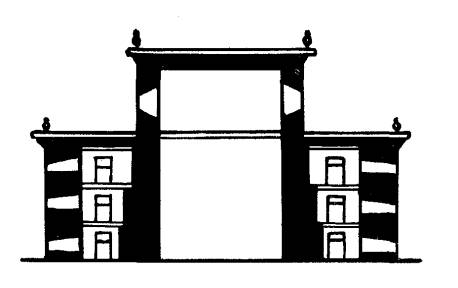
CROSS SECTION OF THE Great Tabernacle ARRANGEMENT OF ROOMS IN ANNEX
This cross-section of the Great Tabernacle is intended to show how the annex fitted into the general plan of the tabernacle. For a general view, the plan of the Great Tabernacle should be consulted. The lateral buildings comprised, as can be seen, three floors of small rooms, the second and third each increasing in length some eighteen inches over the lower floor. It is probable that the whole annex comprised about thirty room, which were used to house the kohens and servants of the tabernacle.
The forecourt, with the altar of holocausts and the bronze 'Sea'
In front of the Great Tabernacle stood a court in the form of a quadrangle enclosed by a wall made of three courses of dressed stone, topped by a course of cedar wood (1 Melechim 6:36). It contained the altar of holocausts and the bronze 'Sea', and was therefore a qadash place. Its purpose was to serve as a place of assembly for the crowds of pilgrims who came to sacrifice to YAHWEH. We do not know its exact dimensions, but 'some archaeologists believe that its area was twice that of the Great Tabernacle. 22
Immediately in front of the entrance to the Great Tabernacle, just above the steep promentary of Ornan's threshing floor, where David had ordered an altar of crude stone and beaten earth to be erected. Solomon, carrying out his father's instructions, erected the altar of holocausts (1 Divre Hayamim 22:1). It was a huge construction of bronze, thirty-two feet long, thirty-two feet wide, and sixteen feet high. 23
This metallic, square-shaped, altar consisted of three superimposed platforms (side measurements: twenty-six feet; twenty-two and a half feet; and nineteen and a half feet respectively). The different levels were reached by means of a slight incline. On the top a fire was kept continually burning, and it was here that the animal victims were consumed as a holocaust (burnt offering). The ashes fell to the ground through a series of grids and so could be easily swept up. 24 On each of its four corners there was a 'horn'. From the top of the platform the kohen could sprinkle the crowd with the blood of the victim.
Around this altar certain curious features could be observed, curious at least to modern ideas. Close to the court, for instance, there was an enclosure like a great market containing a mass of sheep, goats, oxen and bulls. The air was filled with bleating and bellowing. There were stores of fodder, drinking ponds, and dung everywhere. Then, this being the East, buying and selling was an intense and noisy process. Nearer still to the Great Tabernacle, slaughtering was carried out with the resultant blood and stench. And it all ended with the crackling of the meat in the fire on the top of the altar; the court was filled with dense fumes rising from the charred flesh of the victims.
At some distance, south-east of the Great Tabernacle, but still within the court, there stood the 'Sea' of bronze (1 Melechim 7:23-26; 2 Divre Hayamim 4:2-5), an immense bronze basin, molded in the Yarden valley under the skilled direction of Huram-abi. It was a gigantic cup-shaped vat, with a base of twelve bulls, symbolizing the Twelve tribes, their hind-quarters pointing inwards. The animals were divided into four groups of three, each group facing. one of the four cardinal points. Its measurements were astonishing: fifty feet in circumference and eight feet high. According to Melechim, it could hold 2000 baths (20,000 gallons), The author of Divre Hayamim, always inclined to exaggerate, gives the amount as 3000 baths.
The water contained was used for washing by the kohens before the sacrifices. 25
In the volume on Mosheh, it was mentioned that to the right and left of the front of the Tabernacle in the wilderness there stood a basin for the kohen to wash his hands and feet before every spiritual service (Shemoth 30:18), Solomon's bronze 'Sea' had the same purpose,
Access to this 'Sea' appears to have been complicated. Was its huge brim reached by a ladder? Or did it have a movable opening that allowed the water to flow into some more practical vessel? It is impossible to be certain. The so-called 'vase of Amathonte' from Cyprus, now in the Louvre (seven feet in diameter, nearly six feet high, with false handles framing an image of a bull), apparently had a similar function to that of the Great Tabernacle 'Sea'. This was another example of the way the Phoenicians introduced into the Great Tabernacle an object common among the spiritual buildings of the East at that time.
Close to the 'Sea' there were ten stands on wheels for carrying water used in the ritual purification of the animals. They were six and a half feet long, six and a half feet wide and five feet high. Circular vats, six and a half feet deep were placed within them. The weight thus carried was greater than might at first appear; these carriers lightened the burden of transport. They were ornamented with decorative bands of bulls, cherubs and palm-leaves, the customary patterns of the period.
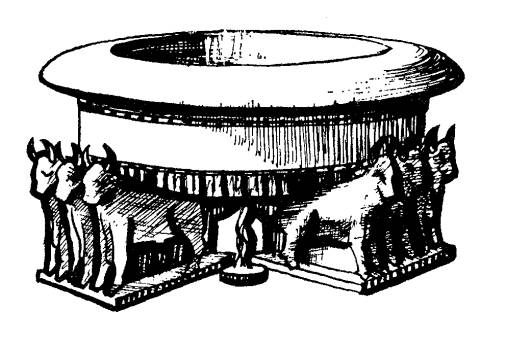
THE SEA OF BRONZE
This enormous bronze cauldron looks like a giant tank in the form of a cup:50 feet in circumference and 8 feet in depth. According to various mentions in the Scripture, it could have held 2,000 baths, approximately 20,000 gallons of water. Hence the appellation "the Sea of Bronze". The whole colossal work rested on the backs of 12 bulls split up into four groups of three animals facing the four cardinal compass-points. Naturally, the bloody sacrifices made oft-repeated washing and purification necessary. Moreover, a huge quantity of water must have been essential for the sanitation of the ceremonial abattoir, where the animals destined for burning on the sacrificial altar had their throats cut. This huge vessel was placed on the right side of the Great Tabernacle.
At first sight, it seems that the kohens would have found access for their ablution difficult. We must think, then, that there was some kind of tap which allowed as much water as desired to flow into waiting lesser vessels. But there is no documentary evidence on this point.
The tank was raised to its plinth in the reign of Ahaz (736-716). This king took the bronze Sea off the oxen supporting it and rested it on the stone pavement (2 Melechim 16:19). It is very possible that the metal was originally cast to be sent as tribute to the King of Assyria, Tiglath-Pileser III, of whom Ahaz had just recognized himself vassal (734).
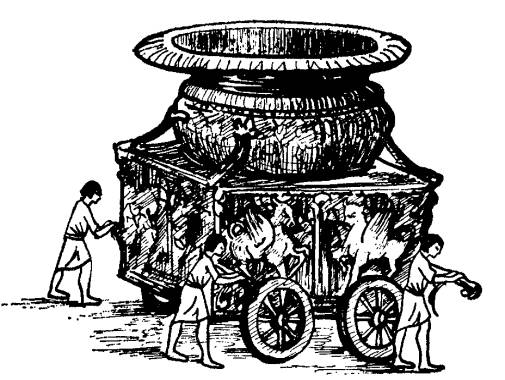
ATTEMPTED RECONSTRUCTION OF A MOBILE VAT (after Babylon, Archeologie orientale)
Near the sea of Bronze stood ten mobile tanks, mounted on wheels which served to carry water to various places where necessary. The cart measured 6 1/2x 6 1/2 ft and 5 ft in height. On it would be placed a large vat. Together, the total height was 71/2 ft. The outside was decorated in classical style with cherubim, palm-leaves, roaring lions, bulls etc.
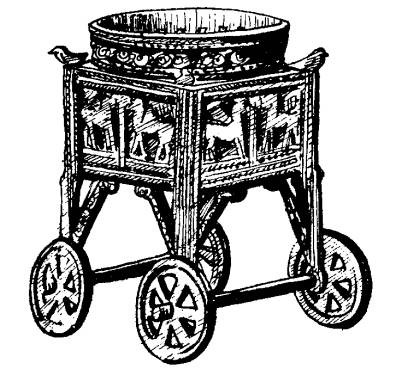
VESSEL ON WHEELS, DISCOVERED AT LARNAK (after Furtwangler)
This cultic object, of modest dimensions (15:1/2 in. high and 9 in. square). was perhaps made to be a votive model. Vessels of the same type have been dug up in Cyprus and at Megiddo. The various bronze chariots are curiously akin to the mobile tanks used around the altar of holocausts established in front of the Great Tabernacle of Solomon.
22 Solomon's successors built a second court, although it is only casually mentioned in the time of King Jehoshaphat (870-848) -(2 Chron 20:5). The first court, erected by Solomon, was then given the name of the inner court, because it was in a more central position within the enclosure.
23 The Books of Melechim give no description of Solomon's altar, but, with reference to the dedication of the Great Tabernacle, simply mention its existence (1 Melechim 8:14). Divre Hayamim (2 Divre Hayamim 4:1) has more to say and provides information of great interest.
24 In spite of its impressive size, the altar of holocausts occupied only a part of the 'rock' of Ornan, as it exists today. It measures fifty-seven and a half feet by forty-four, whereas the base of the altar was only twenty-seven feet by twenty seven feet. A groove in the stone may have served to attach a part of the bronze layers of the structure, unless indeed it was the work of the Crusaders -the Templars who built a church here, erected its high altar immediately above the 'rock' of Ornan.
25 In spite of the silence of Scripture, it seems probable that this enormous supply of water was essential for the constant cleansing necessitated by the slaughter of the animals, their removal, and the blood that flowed from their severed quarters How was such a quantity of water brought up to the level of the Great Tabernacle? Very probably by a system of aqueducts leading north from the mountain. Once the water had been used, it was poured back into the bed of the Kidron or Tyropoeon by means of underground channels just beneath the soil So far, none of these has been discovered.
The leveling of the threshing-floor to make the Great Tabernacle base
The Great Tabernacle was a small building; even so it could not have been constructed on the threshing-floor without preparation. At Tyre, Hiram's workmen had filled up the inlets of the sea and transformed an insignificant rocky archipelago into an imposing city. It was unlikely, therefore, that they would have found much difficulty in transforming a threshing-floor into a broad level space. They were faced with two problems only: money and man-power.
David had bequeathed Solomon chestfuls of gold, and he had an army of labourers at his disposal, from whom he could exact constant and inhuman work. The great empires of the Nile valley or of Mesopotamia had demonstrated that, given sufficient labourers, controlled by the whip, it was possible to build colossal pyramids and enormous ziggurats. Solomon's plan to build a little Great Tabernacle was therefore quite within bounds, even if it did involve the task of flattening a very uneven piece of ground.
So the preliminary work was begun: the leveling of the rock and the elimination of outcrops, but respecting the king's desire to preserve the noble appearance of Ornan's floor. Around this a walk had to be constructed on the same level. Large quantities of earth were needed to fill up the empty spaces, and this had to be carried either on the shoulders of the men or the heads of the women. 26
This was only one of the simplest aspects of the problem. In order to support this huge tonnage of soil, and, even more importantly, to make a considerable increase in the extent of the base on which the Great Tabernacle was to be built, 27 Solomon encased Mount Moriah in a colossal chest of masonry with the aim of eliminating the abrupt slopes. For this purpose very thick walls of gigantic dressed stones were erected. Scripture says that these stones were between 13 and 15 feet long, and in fact modern excavations have unearthed still larger specimens underneath the foundations of the Great Tabernacle and the palace. The result of all this was that instead of the steep ridge of the former threshing-floor, inadequate as the foundation of a large building, Hiram's craftsmen had produced a majestic stretch of even ground, a place where the building of a Great Tabernacle to YAHWEH could fittingly be begun.
We can gather some idea of Solomon's achievement if we take a look at Haram esh-Sherif, a great stretch of level ground (1,593 feet long by 1040 wide) on which the Dome of the Rock has been erected. (plans below). But the huge prospect we see today is not exactly the same as that which was produced in 967. During the centuries profound changes were effected, especially by Herod, and later by the Byzantines and the Arabs. But these alterations have been poorly recorded, and Scripture supplies only the most meager information about the construction of this immense foundation. Careful soundings made in the Haram esh-Sherif would no doubt enable archaeologists to solve the problem. But because there are shrines of Islam on this ground, Mohammedan authorities have consistently refused all requests to begin excavations, so there is still uncertainty about the exact measurements of the surface on which the Great Tabernacle rested.
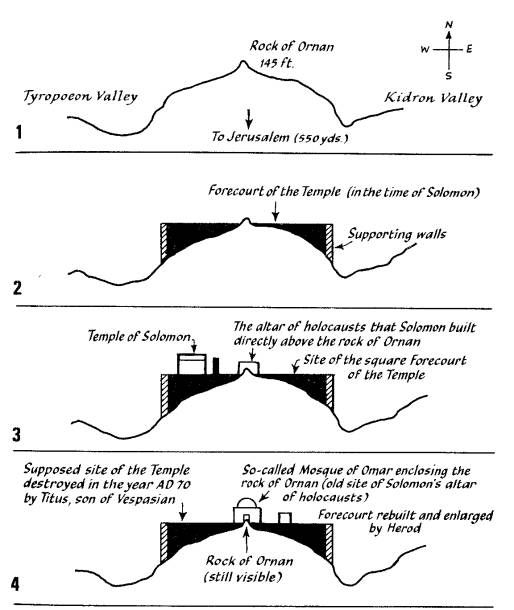
THE TRANSFORMATIONS OF THE FORECOURT OF THE Great Tabernacle
1. Cross-sectional view of the rock of Ornan in the time of David.
2. The building of Solomon's forecourt planned to be the base of the Great Tabernacle; only the topmost point of the underlying rock appeared above the paving. The dimensions of the exposed limestone stab = 19.6 x 14.4 yards 3. The altar of holocausts established on the rock of Ornan. The Great Tabernacle west of the rock. The entrance of the Great Tabernacle is on the east, facing the altar of holocausts.
4. Present state of the forecourt. The so-called Mosque of Omar encloses the rock of Ornan which is still visible. To the west, between the Islamic building and the western supporting wall (dating from the time of Solomon), the old site of the Great Tabernacle.
26 The word millo, from the root mille, to fill, appears to signify the filling in of these gaps. The word has misled some scholars; it may be paraphrased: the embankment of the surface in every direction.
27 Together with this work. Solomon was also careful to level the downward slope on the Yerusalem side. It was here. on a second stretch between the level of the Great Tabernacle and Yerusalem, that immediately after the building of the Great Tabernacle, work was begun on the royal palace.
The dimensions of the Great Tabernacle
Melechim and Divre Hayamim provide information about the Great Tabernacle's inner surfaces only. It is true that Yehezqel in his vision of the ideal Great Tabernacle -the Great Tabernacle to be rebuilt by the Hebrews when they were free to return from their Babylonian Exile -gives details about the thickness of some of the walls. But do his figures apply to the building that had been destroyed by Nebuchadnezzer, or were they only the measurements of that future Great Tabernacle he hoped for? From the nature of the case, the question is insoluble. But archaeologists have been at such great pains to work out the combined measurements of the area covered by the Great Tabernacle and its annex (the two structures were intimately conjoined) that the estimate of 80 feet wide and 160 in length, may be taken as substantially accurate. Evidently it was comparatively small; seven or eight editions of Solomon's Great Tabernacle could have fitted comfortably inside Notre Dame. It follows that the level ground on which it rested could not have been of sufficient size to support anything more imposing.
The discovery of the little Syrian temple of the Tell Tainat, dated as of the ninth century by American archaeologists, that is, a century later than the Phoenician work done for Solomon in Yerusalem, has introduced new ideas about architectural development during this period.28
Its measurements (frontage about 40 feet, and length about 90 feet -about half those of Solomon's Great Tabernacle) suggest that, in the time of Hiram I, Phoenician architecture turned away from the age-old ideals of huge buildings that overwhelmed by their size, towards constructions on a more human scale. New discoveries will probably support this view.
Historians and archaeologists have long been at odds over the exact site where the Great Tabernacle stood on the leveled ground, and their controversy is by no means settled. Some hold that it was built on the 'rock' of Ornan. On this view, the Ark would have had an honourable position on the ancient limestone base where David had erected an altar for his sacrifice. This would mean that the Qadash of Qadash had its place practically in the middle of the ground, and yet it is certain that the front of the building faced east, that is, towards the valley of the Kidron. This being so, how could Solomon have possibly constructed a fore-court facing its entrance? (plan above). The idea is scarcely credible.
In any case, the Scripture gives a clear account of the part played by the 'rock' of Ornan in the organization of worship in the future Great Tabernacle. As soon as David had concluded his sacrifice for the removal of the plague, he exclaimed prophetically: 'Here [on this set apart rock] is the house of YAHWEH; and this shall be the altar of holocaust for Yisrael' (1 Divre Hayamim 22:1). It is abundantly clear: on the promontory where Ornan formerly threshed his corn, the altar of holocausts was to be erected. Consequently it would be in the open air in front of the Great Tabernacle entrance. There was no question of building the Qadash of Qadash in this place, or of making it the resting place for the Ark. The Scriptural narrative makes the architectural layout unmistakable: (plan above, 3rd section) almost in the middle of the sketch of leveled ground there is the 'rock' of Ornan where the altar of holocausts was established; westwards stands the Great Tabernacle whose apse overshadows the Tyropoeon ravine; and to the east, but still on the same level stretch of ground, between the 'rock' and the slope facing Kidron, stood the vestibule.
28 Bulletin of the Oriental Institute of the University of Chicago, 1937. No 1, p 13 American Journal of Archaeology, 1937, p 9, fig 4
Back Solomon The Magnificent Next
Solomon The Magnificent Index Solomon Sitemap Scripture History Through the Ages Solomon The Historian RADIANT DAWN Solomon's Wisdom SOLOMON IN ALL HIS HONOR David's role in building the Temple Dates of the building of the Temple Division of the Temple The Ark of the Covenant The most Kodesh Place Dedication of the Temple SOLOMON Prince of Peace SOLOMON THE TRADER Solomon's Ophir expedition The queen of Sheba LITERARY ACHIEVEMENTS OF SOLOMON First historical works of the Hebrews What did Solomon write THE SHADES OF NIGHT Political and social failure Solomon's spiritual failure The moral failure of Solomon CONCLUSION of Solomon
